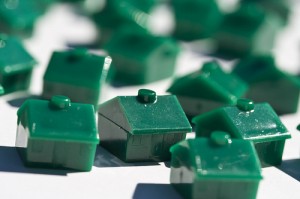Nothing But Houses!
 Megan McArdle starts off a post by summarizing a column:
Megan McArdle starts off a post by summarizing a column:
James Surowiecki has a very interesting column arguing that this bubble was different because unlike the earlier banking booms, there was no point to the wild spending. The bubble didn’t bring us railroads and electrification; it brought us . . . houses. Lots and lots and lots of houses.
Megan goes on to argue that this bubble was more complicated that just houses. But taking Surowiecki’s premise at face value and presuming that all we got were, in fact, lots of houses, I offer the Paul McCartney Rebuttal: What’s wrong with that, I’d like to know?
While there are arguments to be made about suburban sprawl and negative externalities and so forth, houses per se are a pretty good thing. People live in them. They get pride of ownership, a place for their stuff, and so forth. People like houses.
Photo by Flickr user woodleywonderworks, used under Creative Commons license.




She omits the word “empty” before “houses”, which is kind a large omission.
Empty now, sure. But when they were giving away money to anyone who could walk through a front door, regardless of income or credit-worthiness they were not.
From my perspective, ‘middle-class America’ has gone quite status crazy. People need houses to live in, but does a family of three or four need a four bedroom house with three and a half baths, kitchen, formal dining room, living room, family room, finished basement, and a two or three stall garage? When my friends from Europe visited and we used to drive through the new housing developments they would often comment on our wasteful arrogance (and my friends from Eastern Europe couldn’t even comprehend that these were single-family dwellings). These (relatively) young families were mortgaged to the hilt in order to keep up with the Joneses and many lived one paycheck from bankruptcy. Now that paycheck isn’t there …
The problem with a bubble in houses is that they are not and will not be income producing infrastructure on the whole. Railroads, electrification and fiber optic cable were all bubblicious in their time and collapsed. However, that infrastructure was taken over in time by more prudent investors and became part of an economic expansion, via larger markets due to shipping, electrical product sales and electricity intensive industry, and high speed internet and electronic media distribution.
Houses, barring some unexpected influx of people needing lodging, will not become stepping stones to other industrial and economic expansion. Instead, home values will remain depressed and the home building industry will languish until the excess inventory is disposed of either by occupancy or demolition.
I suppose someone could come along and open a string of brothels across the country that would transform some of the excess housing into economic activity?
Out where I live, they built house on postage stamp size lots. The houses they built were very pricey however all you got was house. There was no property. If you broke wind your neighbor heard it. No back yard and no front yard. Where would the kids play. At the park they built down the way. This was all once truck farm land. There was plenty of acerage. It was pure greed that built these two story ugly ugly houses in a way that would make anyone with any sense not buy. Over in the bay area, land is at a premium and I understand to a degree why they built how they do, however Sacramento has lots of open space to built houses that were very overpriced. To bad the developers got to take their money and run.
Calculated Risk: Demolished Houses
I guess those houses are kind of like the overinvestment in fiber-optic cable during the dot-com bubble. There was way too much cable at first, but the world has caught up and the cable has yielded great benefits, economic and otherwise. (Now they want to lay more cable.)
The same can be said for the empty houses — assuming they don’t crumble before anyone can move in.
I think the point was that previous bubbles ultimately brought innovation – foolish gold rush investments fostered technologies and industries that didn’t exist before. Electricity, Railroads internet. Housing was hardly new. Yes, we might be better off with more houses (certainly not worse off?) but we didn’t make progress. Progress seemed to be a byproduct of previous bubbles. It wasn’t with this one. (Unless you count the creation of highly complex and shaky financial instruments as progress). This bubble was more akin to the old Tulip bubble.
As Bystander noted, the problem isn’t too many houses but too extravagant houses, much more than could be afforded. Imagine Toyota, Honda and Nissan deciding that they would only henceforth produce Lexus’, Acuras, and Infinitis.
I think the best answer, James, is Opportunity Costs.
Was it the best possible use of forward earnings (borrowed) for those people to all buy houses? Did they have their investments and retirement covered? Did they even have their safety accounts established?
On the national level, in this time of globalization and adjustment, did we need more houses? Or should we have gone with more advanced factories? Better universities?
I’m thinkin’ I like JKB’s entrepreneurial spirit…..